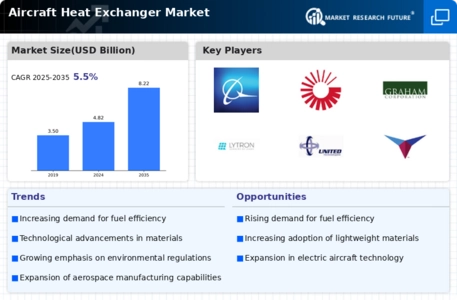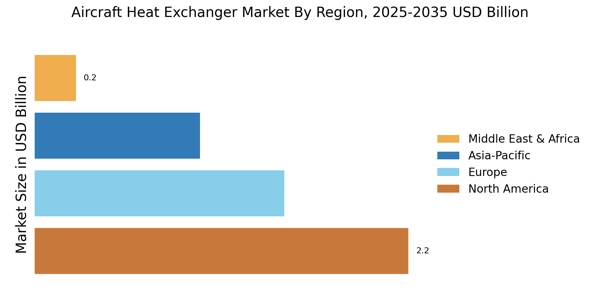Increasing Demand for Fuel Efficiency
The Aircraft Heat Exchanger Market is experiencing a notable surge in demand for fuel-efficient aircraft. As airlines and manufacturers strive to reduce operational costs and environmental impact, the focus on advanced heat exchangers has intensified. These components play a crucial role in optimizing engine performance and enhancing thermal management systems. According to recent data, the aviation sector is projected to grow at a compound annual growth rate of approximately 4.5% over the next decade, further driving the need for innovative heat exchanger solutions. This trend indicates a shift towards more efficient designs that not only improve fuel economy but also comply with stringent regulatory standards. Consequently, manufacturers are investing in research and development to create heat exchangers that meet these evolving demands, thereby propelling the Aircraft Heat Exchanger Market forward.
Growth in Aircraft Production and Deliveries
The Aircraft Heat Exchanger Market is poised for growth due to the increasing production and deliveries of commercial and military aircraft. With the rise in air travel demand, manufacturers are ramping up production to meet the needs of airlines and defense sectors. Recent statistics indicate that aircraft deliveries are expected to reach over 40,000 units in the next decade, which directly correlates with the demand for heat exchangers. These components are essential for maintaining optimal operating temperatures in various aircraft systems, including engines and avionics. As production rates increase, the Aircraft Heat Exchanger Market is likely to benefit from economies of scale, leading to cost reductions and enhanced product offerings. This growth trajectory suggests a robust future for heat exchanger manufacturers as they align their strategies with the expanding aircraft production landscape.
Regulatory Compliance and Environmental Standards
The Aircraft Heat Exchanger Market is significantly influenced by stringent regulatory compliance and environmental standards. Governments and aviation authorities worldwide are implementing more rigorous emissions regulations, compelling manufacturers to adopt advanced technologies in heat exchanger design. These regulations aim to minimize the environmental footprint of aircraft operations, thereby increasing the demand for efficient thermal management systems. For instance, the International Civil Aviation Organization has set ambitious targets for reducing greenhouse gas emissions, which has led to a heightened focus on sustainable aviation practices. As a result, manufacturers are compelled to innovate and enhance the performance of heat exchangers to meet these standards, thereby driving growth in the Aircraft Heat Exchanger Market. This regulatory landscape not only fosters technological advancements but also encourages collaboration among stakeholders to develop eco-friendly solutions.
Technological Innovations in Heat Exchanger Design
The Aircraft Heat Exchanger Market is witnessing a wave of technological innovations that are reshaping the design and functionality of heat exchangers. Advancements in materials science, such as the development of lightweight and high-conductivity materials, are enabling the creation of more efficient heat exchangers. These innovations not only enhance thermal performance but also contribute to weight reduction, which is critical in aviation applications. Furthermore, the integration of smart technologies, such as sensors and automation, is improving the monitoring and management of heat exchanger systems. This trend indicates a shift towards more sophisticated designs that can adapt to varying operational conditions. As manufacturers continue to invest in research and development, the Aircraft Heat Exchanger Market is likely to see a proliferation of cutting-edge solutions that meet the demands of modern aircraft.
Rising Focus on Sustainability and Eco-Friendly Solutions
The Aircraft Heat Exchanger Market is increasingly aligning with the global focus on sustainability and eco-friendly solutions. As environmental concerns gain prominence, stakeholders in the aviation sector are prioritizing the development of heat exchangers that minimize energy consumption and reduce waste. This shift is evident in the growing adoption of sustainable materials and manufacturing processes aimed at lowering the carbon footprint of aircraft components. Additionally, the push for alternative fuels and energy-efficient technologies is driving innovation in heat exchanger design. Recent studies suggest that the market for sustainable aviation technologies is expected to grow significantly, indicating a strong potential for heat exchanger manufacturers to capitalize on this trend. By embracing sustainability, the Aircraft Heat Exchanger Market not only addresses regulatory pressures but also meets the evolving expectations of environmentally conscious consumers.


















Leave a Comment